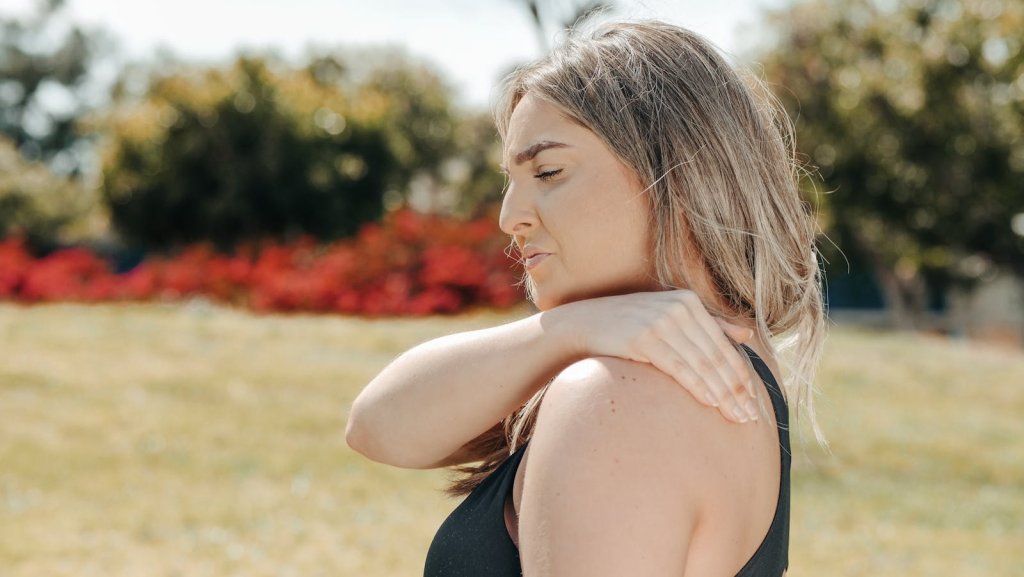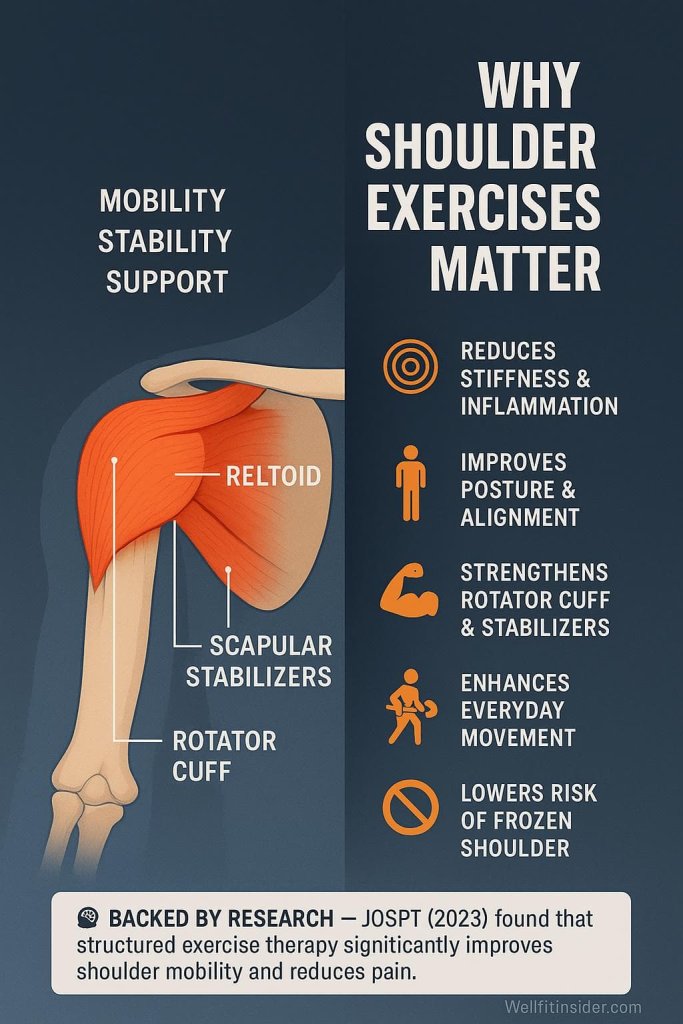Yes — you can relieve shoulder pain and restore flexibility with the right exercises.
Gentle mobility and strengthening moves can ease stiffness, improve range of motion, and prevent future pain.

Shoulder pain often stems from poor posture, rotator cuff weakness, or overuse — and exercise is one of the most effective, non-invasive ways to manage it. Whether you’re recovering from a mild strain, dealing with chronic tightness, or trying to maintain joint health, this guide will show you 12 expert-approved shoulder pain exercises you can do safely at home.
(Always consult your healthcare provider before starting if you have an injury or persistent pain.)
Why Shoulder Exercises Matter
Your shoulder joint is one of the most mobile — and therefore unstable — joints in the body.

Targeted exercises:
- Reduce stiffness and inflammation
- Improve posture and shoulder alignment
- Strengthen the rotator cuff and stabilizer muscles
- Enhance daily movement (reaching, lifting, dressing)
- Lower the risk of frozen shoulder or tendonitis
A 2023 review in The Journal of Orthopaedic & Sports Physical Therapy (JOSPT) found that structured exercise therapy significantly improves shoulder mobility and pain levels in both rotator cuff and impingement conditions.
12 Best Shoulder Pain Exercises
Below are the 12 most effective, science-backed shoulder exercises, grouped into mobility/flexibility and strength/stability categories.
Perform 1–2 sets of each, 10–15 reps or 30–60 seconds per move, 3–4 times weekly.
Mobility & Flexibility Exercises
1. Pendulum Stretch
Why it works: This gentle motion relieves stiffness and helps lubricate the shoulder joint capsule — a key move after injury or surgery.
Muscles worked: Deltoids, rotator cuff, trapezius (light activation).
How to do it:
- Lean forward, placing your healthy arm on a sturdy table for support.
- Let your affected arm hang freely down.
- Begin making small circular motions with the hanging arm — clockwise, then counterclockwise.
- Gradually increase the circle size as pain allows.
Trainer Tip: Keep the movement slow and relaxed — it should feel soothing, not forced. Avoid using shoulder muscles to swing; let gravity do the work.
2. Cross-Body Shoulder Stretch
Why it works: Improves flexibility in the rear shoulder capsule and posterior deltoid, helping restore full range of motion.
Muscles worked: Posterior deltoid, rhomboids, rear rotator cuff.
How to do it:
- Raise one arm across your chest at shoulder height.
- Use your opposite hand to gently pull the arm closer to your chest, just above or below the elbow.
- Hold for 20–30 seconds; repeat 2–3 times per side.
Trainer Tip: Keep shoulders down and relaxed — don’t twist your torso or lift your shoulder toward your ear.
3. Doorway (Pectoral) Stretch
Why it works: Opens tight chest and front shoulder muscles that often cause rounded shoulders and poor posture.
Muscles worked: Pectoralis major and minor, anterior deltoids.
How to do it:
- Stand in a doorway with elbows bent 90° and hands on either side of the frame.
- Step forward slowly until you feel a stretch across your chest and shoulders.
- Hold 20–30 seconds, keeping your neck neutral.
Trainer Tip: Don’t overarch your lower back — keep your ribs down and core lightly engaged.
4. Thread the Needle
Why it works: Improves shoulder and upper back rotation while releasing tension in the posterior chain.
Muscles worked: Posterior deltoid, rhomboids, middle trapezius, obliques.
How to do it:
- Start on all fours (hands under shoulders, knees under hips).
- Slide your right arm under your left arm, palm facing up.
- Gently lower your right shoulder and ear to the floor.
- Hold 20–30 seconds, then switch sides.
Trainer Tip: Breathe deeply and relax into the stretch — avoid pushing past mild tension.
5. Open-Book Stretch
Why it works: Enhances thoracic spine and shoulder rotation, key for pain-free overhead movement.
Muscles worked: Rhomboids, mid traps, rotator cuff, spinal erectors.
How to do it:
- Lie on your side with knees bent and arms extended straight in front.
- Open your top arm across your body, rotating your torso until your shoulder touches the ground.
- Hold for 15–20 seconds; repeat on the other side.
Trainer Tip: Keep your knees stacked together — it isolates the upper-body rotation and prevents low-back compensation.
6. Overhead Triceps Stretch
Why it works: Lengthens tight triceps and the long head of the biceps, improving shoulder overhead range.
Muscles worked: Triceps brachii, long head of biceps, lats (minor).
How to do it:
- Raise one arm overhead and bend the elbow so your hand touches your upper back.
- Use your other hand to gently press the elbow backward.
- Hold for 20–30 seconds per side.
Trainer Tip: Keep your ribs down and spine tall — avoid arching your back.
Strength & Stability Exercises
7. Wall Slide (Scapular Slide)
Why it works: Strengthens the serratus anterior — crucial for shoulder blade control and stability.
Muscles worked: Serratus anterior, lower trapezius, rotator cuff.
How to do it:
- Stand with your back, head, and arms against a wall.
- Slide your arms upward in a “Y” motion, maintaining contact with the wall.
- Slowly lower back to start.
- Do 10–12 reps.
Trainer Tip: Keep core engaged and avoid shrugging shoulders. Quality of motion matters more than height.
8. YTWL Shoulder Series
Why it works: Builds endurance in scapular stabilizers and rotator cuff muscles, improving posture and shoulder control.
Muscles worked: Lower and middle trapezius, rhomboids, rotator cuff (supraspinatus, infraspinatus, teres minor).
How to do it:
- Lie face-down on a bench or stability ball.
- Move your arms into “Y,” “T,” “W,” and “L” shapes — lifting slightly each time.
- Hold each for 2–3 seconds before lowering.
Trainer Tip: Use light weights or no weights — focus on slow, controlled movement and scapular retraction.
9. External Rotation with Band
Why it works: Strengthens the external rotators — key for shoulder alignment and injury prevention.
Muscles worked: Infraspinatus, teres minor, posterior deltoid.
How to do it:
- Attach a resistance band to a stable object at elbow height.
- Hold the band with your working arm, elbow bent 90°, tucked at your side.
- Pull the band away from your body, pause, then return slowly.
- Do 2 sets of 15 reps per side.
Trainer Tip: Keep elbow glued to your ribs — use a small towel between arm and torso to ensure proper form.
10. Internal Rotation with Band
Why it works: Balances external rotation strength to maintain joint stability.
Muscles worked: Subscapularis, anterior deltoid, pectoralis major (secondary).
How to do it:
- Anchor a band to the side at elbow height.
- Hold the band with elbow bent 90°, close to your body.
- Pull inward toward your abdomen, then return slowly.
Trainer Tip: Keep movement small — focus on slow control rather than tension from a heavy band.
11. Scapular Retraction (Shoulder Blade Squeeze)
Why it works: Strengthens postural muscles that prevent forward shoulder rounding.
Muscles worked: Rhomboids, middle trapezius.
How to do it:
- Sit or stand tall with arms by your sides.
- Squeeze your shoulder blades together gently and hold for 5 seconds.
- Relax and repeat 10–15 times.
Trainer Tip: Avoid shrugging your shoulders — keep them down and back for proper engagement.
12. Serratus Punch
Why it works: Trains the serratus anterior — crucial for shoulder stability, especially during overhead and pushing movements.
Muscles worked: Serratus anterior, pectoralis minor, rotator cuff stabilizers.
How to do it:
- Lie on your back with a light dumbbell in one hand.
- Extend your arm straight up toward the ceiling.
- “Punch” upward by lifting your shoulder blade off the ground, then lower slowly.
- Do 2 sets of 10–12 reps.
Trainer Tip: Keep elbow locked but not hyperextended — the motion comes from your shoulder blade, not your arm.
Safety Tips for Shoulder Pain Exercises
- Warm up with gentle arm circles before starting.
- Avoid pushing into sharp pain.
- Move slowly and maintain control.
- If pain worsens or radiates down your arm, stop and seek medical advice.
- Perform stretches daily; strength moves 3–4× per week.
When to See a Doctor
Seek medical evaluation if:
- Pain lasts more than 2 weeks
- You experience swelling, redness, or warmth
- You can’t lift or rotate your arm
- There’s sudden weakness or numbness
FAQ: Shoulder Pain Exercises
1. Can shoulder exercises replace physical therapy?
Not entirely. These moves can maintain mobility, but severe or chronic shoulder issues should be treated under professional supervision.
2. How often should I do shoulder pain exercises?
Gentle mobility stretches daily; strengthening moves 3–4× per week.
3. Should I use weights or bands?
Start with bodyweight or light resistance bands. Gradually increase tension as strength improves.
4. Can these help frozen shoulder?
Yes, gradual stretching (like pendulum and wall slides) can help regain motion — but proceed very slowly.
5. Is it normal to feel soreness?
Mild soreness is fine, but stop if pain feels sharp, stabbing, or worsening.
6. Do posture exercises help shoulder pain?
Absolutely. Strengthening your back and scapular muscles reduces forward-shoulder stress.
7. Can I do these after surgery?
Only under your surgeon or therapist’s clearance. Post-surgical protocols differ.
Conclusion
Consistent, gentle movement is key to relieving shoulder pain naturally.
By combining mobility stretches and strengthening drills, you can rebuild flexibility, stability, and confidence in your shoulder.
Start slow, stay consistent, and you’ll notice improved comfort within weeks.
If you need long-term guidance, consider consulting a physical therapist for a tailored recovery plan.
References
- American Academy of Orthopaedic Surgeons (AAOS).
Rotator Cuff & Shoulder Conditioning Program — OrthoInfo (Updated 2024)
Official AAOS guide with detailed shoulder strengthening and flexibility exercises for rehabilitation.
- American Academy of Orthopaedic Surgeons (AAOS).
Shoulder Conditioning Program — PDF Guide
Printable resource outlining evidence-based rehab stretches and strengthening progressions.
- Cochrane Database of Systematic Reviews.
Manual Therapy and Exercise for Rotator Cuff Disease (2016)
Systematic review confirming that exercise and manual therapy outperform rest or placebo in shoulder rehabilitation.
- National Institute for Health and Care Excellence (NICE).
Shoulder Pain — Initial Management & Red Flags (2024)
Guidelines on when to use self-management, exercise therapy, or seek medical evaluation for shoulder pain.
- Lafrance S, et al. (2022).
Clinical Practice Guideline for Rotator Cuff Disorders — PubMed. Evidence-based recommendations for conservative management of shoulder pain, including exercise therapy.
- Lowry V, et al. (2024).
Systematic Review of Clinical Practice Guidelines for Shoulder Pain — PubMed
Review assessing the quality and consistency of international shoulder pain management guidelines.
